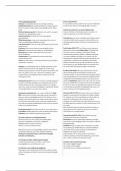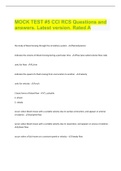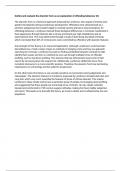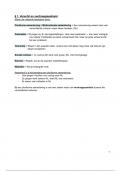Corporate Finance Debate Topics
PART 1
The Financial objectives of a corporation (Refer to Lecture 1)
In theory the goal of the firm should be determined by the firm’s owners. However, in
organisational forms with multiple owners, the appropriate goal of the firm and managers is
not clear. Many corporations have thousands of owners (shareholders). Each owner is likely
to have different interests and priorities. Usually the interests of shareholders are aligned for
most important decisions. Regardless of their financial position, all shareholders will agree
they are better off if management makes decisions that increase the value of their shares.
Many people claim that because of the separation of ownership and control in a corporation,
managers have little incentive to work in the interests of the shareholders when this means
working against their own self-interests. This is an agency problem. Managers face the
ethical dilemma of whether to adhere to their responsibility to put the interests of
shareholders first, or their own interests.
This agency problem can be minimised by decreasing the number of decisions managers
must make for when they may disagree with the shareholders. Shareholders often
compensate managers using contracts to incentivise them to comply with their interests tying
the compensation with the corporation's profits or to its share price. This strategy is limited.
By tying compensation too closely to performance, they may be asking managers to take on
more risk than they are comfortable taking. It also may be difficult for the corporation to hire
such talented managers willing to accept the job.
Potential conflicts of interest arise when only the shareholders benefit and others lose from a
decision. There are not only shareholders and managers (the stakeholders) involved, there
are employees who work for the corporation, the communities in which the company
operates, and clients. For instance, the manager may decide to take the interests of other
stakeholders into account in their decisions, such as keeping a loss-generating factory open
because it is the main provider of jobs in a small town, paying above market wages to
factory workers in a developing country.
In some cases, these actions that benefit other stakeholders also benefit the firm’s
shareholders by creating a more dedicated workforce, generating positive publicity with
customers, or other indirect effects. When decisions benefit other stakeholders at the
shareholder’s expense, they represent a corporate charity.
Another way shareholders can encourage managers to work in the interests of shareholders
is to discipline them if they don’t. Especially when they are unhappy with the CEO's
performance. Also, if investors see a well-managed firm, they are more likely to purchase
shares, which drives the price up. The share price continuously gives feedback on
performance. When the price deteriorates, the board of directors may replace the CEO.
, Some may be reluctant to fire the CEO however, as they may be friends with them and may
lack objectivity.
Low share prices create profit opportunities, and then can lead to a hostile takeover of the
corporation - replacing the board of directors and the CEO. Corporate raiders can provide an
important service to shareholders. This threat of takeover is enough to discipline bad
managers usually.
Ordinarily, a corporation is run on behalf of its shareholders. But when a corporation borrows
money, the holders of the firm’s debt also become investors in the corporation. While the
debt holders do not exercise control over the firm, if the corporation fails to repay its debts,
the debt holders are entitled to seize assets of the corporation in compensation for the
default. To prevent this, the firm may attempt to renegotiate with the debt holders, or file for
bankruptcy protection through the judicial system. If they fail, their assets will be transferred
to the debt holders. The control of the firm passes from equity holders to debt holders.
Bankruptcy involves shutting down the business and selling off its assets. When debt
holders takeover, it is in their best interest to run the firm in the most profitable way possible,
keeping the business running.
Modigliani-Miller 1: Leverage, arbitrage and Firm Value (see lecture 7&8)
Proposition 1: in a perfect capital market, the total value of the firm is equal to the market
value of a firm is equal to the market value of the total cash flows generated by its assets
and is not affected by its choice of capital structure.
Perfect Capital markets:
1) Investors and firms can trade the same set of securities at competitive market prices
equal to the present value of their future cash flows.
2) There are no taxes , transaction costs or insurance costs associated with security
trading.
3) A firm’s financing decisions do not change the cash flows generated by its
investments, nor do they reveal information about them.
In the absence of taxes or other transaction costs, the total cash flow paid out to all firm’s
security holders is equal to the total cash flow generated by the firm’s assets. Therefore, by
the law of one price, the firm’s securities and assets must have the same total market value.
Thus, as long as the firm’s choice of securities does not change the cash flows generated by
its assets, this decision will not change the total value of the firm or the amount of capital it
can raise.
If securities are fairly priced, then buying or selling them has a NPV of zero and, therefore,
should not change the firm’s value = separation principle.
The future repayments that the firm must make on its debt are equal in value to the amount
of the loan it receives up front. Therefore, there is no net gain or loss from using leverage,
and the value of the firm is determined by the present value of the cash flows from its current
and future investments.
PART 1
The Financial objectives of a corporation (Refer to Lecture 1)
In theory the goal of the firm should be determined by the firm’s owners. However, in
organisational forms with multiple owners, the appropriate goal of the firm and managers is
not clear. Many corporations have thousands of owners (shareholders). Each owner is likely
to have different interests and priorities. Usually the interests of shareholders are aligned for
most important decisions. Regardless of their financial position, all shareholders will agree
they are better off if management makes decisions that increase the value of their shares.
Many people claim that because of the separation of ownership and control in a corporation,
managers have little incentive to work in the interests of the shareholders when this means
working against their own self-interests. This is an agency problem. Managers face the
ethical dilemma of whether to adhere to their responsibility to put the interests of
shareholders first, or their own interests.
This agency problem can be minimised by decreasing the number of decisions managers
must make for when they may disagree with the shareholders. Shareholders often
compensate managers using contracts to incentivise them to comply with their interests tying
the compensation with the corporation's profits or to its share price. This strategy is limited.
By tying compensation too closely to performance, they may be asking managers to take on
more risk than they are comfortable taking. It also may be difficult for the corporation to hire
such talented managers willing to accept the job.
Potential conflicts of interest arise when only the shareholders benefit and others lose from a
decision. There are not only shareholders and managers (the stakeholders) involved, there
are employees who work for the corporation, the communities in which the company
operates, and clients. For instance, the manager may decide to take the interests of other
stakeholders into account in their decisions, such as keeping a loss-generating factory open
because it is the main provider of jobs in a small town, paying above market wages to
factory workers in a developing country.
In some cases, these actions that benefit other stakeholders also benefit the firm’s
shareholders by creating a more dedicated workforce, generating positive publicity with
customers, or other indirect effects. When decisions benefit other stakeholders at the
shareholder’s expense, they represent a corporate charity.
Another way shareholders can encourage managers to work in the interests of shareholders
is to discipline them if they don’t. Especially when they are unhappy with the CEO's
performance. Also, if investors see a well-managed firm, they are more likely to purchase
shares, which drives the price up. The share price continuously gives feedback on
performance. When the price deteriorates, the board of directors may replace the CEO.
, Some may be reluctant to fire the CEO however, as they may be friends with them and may
lack objectivity.
Low share prices create profit opportunities, and then can lead to a hostile takeover of the
corporation - replacing the board of directors and the CEO. Corporate raiders can provide an
important service to shareholders. This threat of takeover is enough to discipline bad
managers usually.
Ordinarily, a corporation is run on behalf of its shareholders. But when a corporation borrows
money, the holders of the firm’s debt also become investors in the corporation. While the
debt holders do not exercise control over the firm, if the corporation fails to repay its debts,
the debt holders are entitled to seize assets of the corporation in compensation for the
default. To prevent this, the firm may attempt to renegotiate with the debt holders, or file for
bankruptcy protection through the judicial system. If they fail, their assets will be transferred
to the debt holders. The control of the firm passes from equity holders to debt holders.
Bankruptcy involves shutting down the business and selling off its assets. When debt
holders takeover, it is in their best interest to run the firm in the most profitable way possible,
keeping the business running.
Modigliani-Miller 1: Leverage, arbitrage and Firm Value (see lecture 7&8)
Proposition 1: in a perfect capital market, the total value of the firm is equal to the market
value of a firm is equal to the market value of the total cash flows generated by its assets
and is not affected by its choice of capital structure.
Perfect Capital markets:
1) Investors and firms can trade the same set of securities at competitive market prices
equal to the present value of their future cash flows.
2) There are no taxes , transaction costs or insurance costs associated with security
trading.
3) A firm’s financing decisions do not change the cash flows generated by its
investments, nor do they reveal information about them.
In the absence of taxes or other transaction costs, the total cash flow paid out to all firm’s
security holders is equal to the total cash flow generated by the firm’s assets. Therefore, by
the law of one price, the firm’s securities and assets must have the same total market value.
Thus, as long as the firm’s choice of securities does not change the cash flows generated by
its assets, this decision will not change the total value of the firm or the amount of capital it
can raise.
If securities are fairly priced, then buying or selling them has a NPV of zero and, therefore,
should not change the firm’s value = separation principle.
The future repayments that the firm must make on its debt are equal in value to the amount
of the loan it receives up front. Therefore, there is no net gain or loss from using leverage,
and the value of the firm is determined by the present value of the cash flows from its current
and future investments.










